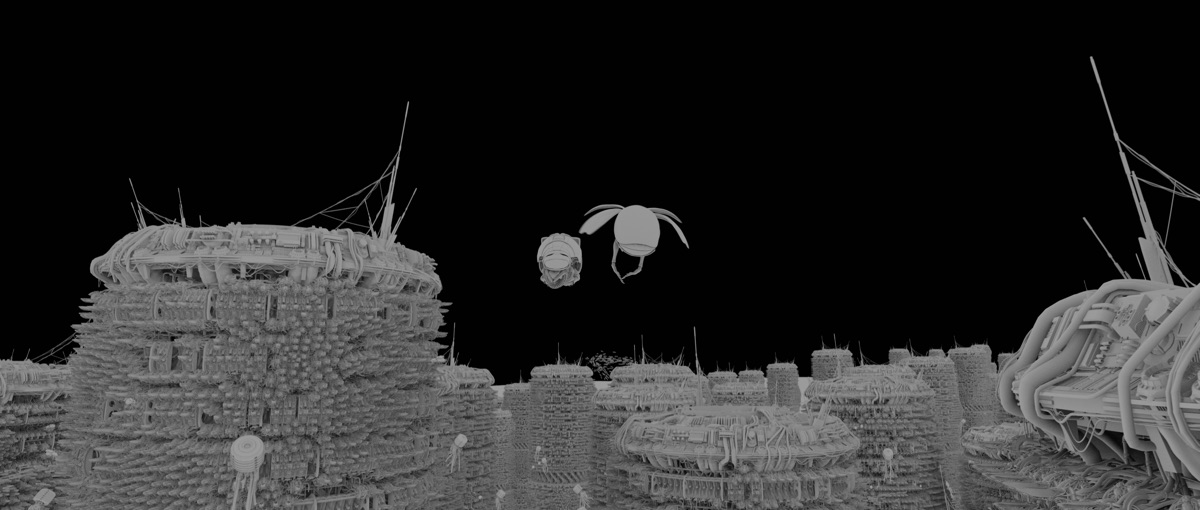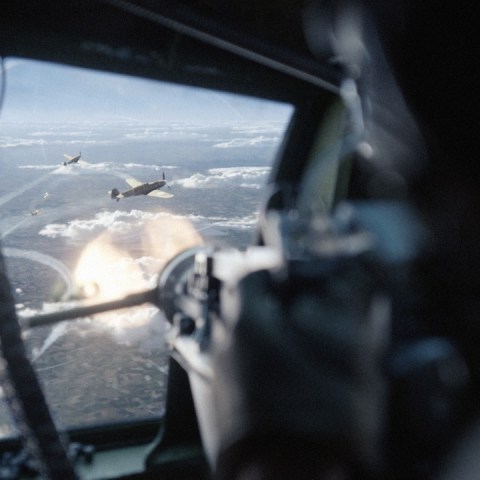Behind DNEG’s visual effects for the return to the real world in ‘The Matrix Resurrections’.
For The Matrix Resurrections, visual effects studio DNEG was responsible for moments in the ‘real world’ when we get to return to the vast foetus fields–those huge stacks of pods housing human ‘batteries’, tended to by harvesters and patrolled by sentinels.
They were fields first witnessed in the original film, of course, and here a bevy of visual effects artists from the studio had to reimagine them several decades later, aided by at least some recovered VFX model data. DNEG visual effects supervisor Huw Evans discusses the process with befores & afters.
b&a: Where did you start with the foetus fields?
Huw Evans: I mean, we obviously had perfect reference from the original movies. We had the highest res files we could get of those movies to reference. We also restored some of the original assets, which were 20 year old assets, which were a challenge to find and get back online and then make usable with modern day tools. But that was really fun to see. There wasn’t a huge amount we could grab. The original baby in the egg was one. We also got the original harvester models, which needed rebuilding and also upgrading to work for close-ups.


We were basically asking around the companies that worked on these assets at the time. Some of them had backups–there wasn’t one place where it was like, ‘Here’s the Matrix assets. It was a little bit like an email chain of, ‘Have you still got these online anywhere?’ Or, ‘I might have some on my home computer backed up.’ It was that kind of thing. So we didn’t get a full set of stuff.
But we did manage to get, well, I think we got a harvester, a doc bot, a sentinel and a foetus egg and stalk, so that was enough that we could use as a perfect reference. We used it as a base, and we recreated it with modern topology. It was fun, just being able to open those scenes and go, ‘Oh, look this, I remember this, this is cool.’
b&a: Tell me about how you were tackling those huge stacks for the fields?
Huw Evans: The stacks were basically modeled procedurally in Houdini by our talented environments team led by Ben Cowell-Thomas. We started with a pod. It was an upgraded version. We referenced the original Matrix when Neo wakes up in the pod where we are looking down the stack. So we referenced that pod, just by eye and by photographs, and recreated that in a good amount of detail, but not going too crazy. Then we added a bunch of connecting cables and additional gubbins to feel like the original Matrix, but Lana wanted it also to feel different. She wanted it to feel a little bit more evolved.


Lana wanted it to feel like the machines had started bolting on extra pods as they need more power, that they’ve started to wedge in more pods here and there. So rather than being perfectly ordered and perfectly straight, you’ll notice they’ve got a slight ‘organic’ bulge to them and there’s little clusters where pods are wedged in rather than all being straight and ordered. So Lana wanted it to feel, not like a fungus growing, but have a bit more of an organic feel rather than a straight, structured order.
We started with a straight stack, all assembled in Houdini so that we could make good use of referencing, and then started to create these extra shapes and different densities. Each tower had an average of 84,000 components, and 18,000 pods with squirming digital humans bound by wires and cables inside. We had concepts from the client and then we also did our own internal concepts to figure out the details.
We’d start with the towers going all the way down and then we also had the root section at the bottom, which you see when the Neo rescue sequence was happening. Here, Lana wanted it to be a little bit like mangrove trees, these massive roots of power getting drawn from the humans down into these huge power columns that spread throughout the city. That was really fun to work out and the environments team did an amazing job of blocking things out really quickly, as procedurally as possible, getting these scenes together that we could then start flying cameras through. The foetus field itself had to be streamlined in its creation as it had arrangements of over 6 million pod stalks along with a vast sprawl of pipes and cables of various sizes scattered all over the place. Our asset creation tools and talented crew guided by Steve Newbold our DFX supe for this section, helped with all this making it as slick as possible.
One thing that really helped us, was, well, we’d basically lit it like the original movies, that was our starting point, but there was a lot more on this one. There was a lot more of a backlit motif that Lana was sprinkling throughout the movie. So working together with lighting supe Simone Vassallo, we added these extra, super strong, almost like work lights that were just hidden in there–we’d never really have one in your face, but they were just hidden off to the side or just poking around the corner of a tower and it just gave us an opportunity to back light mainly the atmos, because there was so much atmos around there, just to try and give it texture and depth. Having these little pin prick back lights shining through really helped just bring it to life a bit more so that it didn’t all fall into flat lighting. Having these little punchy lights pushing through gave us an opportunity to back light sentinels, back light harvesters and atmos as well. Plus, getting a little bit of that kind of red glow from the pods shining through the atmos just really helped give texture.
b&a: The detail in those robots, harvesters and the sentinels is incredible. I’d love you to paint a picture of what it’s like for some of your modelling artists and texture artists to be able to work on something like that. I’m sure they must have loved it.
Huw Evans: I think it was a bit of a dream job. We were really lucky, obviously, getting this film because at the time it was all a bit doom and gloom in the world and people feeling isolated and everyone having to split out and work from home. In terms of the modeling team, James Guy, the build supe for these creatures, and his team of artists, I think had a blast working on them. Like I say, we restored some original assets so having that as a base and building on that gives them an opportunity to just think about what cool extra details you could add, on top of remodelling the old assets of course.


In some of the sentinels, for example, they’d have joints that were just arbitrarily slightly floating or not really intersecting as nicely as they could be, so building these extra little details that you can really go to town on and little cogs and cables–I think that was lovely for the artists. We had to be really careful that we didn’t change anything too much, because they’re such iconic creatures and characters. We wanted to make sure that we were staying true to the originals but making sure that they held up for modern cinema and modern day audiences.
b&a: What kind of live action could they film of Keanu and Carrie-Ann for any of these foetal field shots?
Huw Evans: For the traveling through the foetus fields, we obviously shot most of the stuff with Keanu in a pod before he is rescued. Then as he’s getting carried, we shot all the close-ups of him effectively lying on a chair acting constrained and we then put the creature around him and the goo and everything. Then all of the wide shots were full CG. We had a bit of a merge when he comes into land at the end and gets put down on the table inside the ship. We shot some live action, we did some CG takeovers and ended up with quite a CG heavy result for this moment in the end. For Trinity in her pod, she was shot practically, and we had some digi-double work, too. She was shot with a lot of rigging because she was being picked up by these creatures. We did a lot of takeovers and replacements using sections of practical with CG.




















